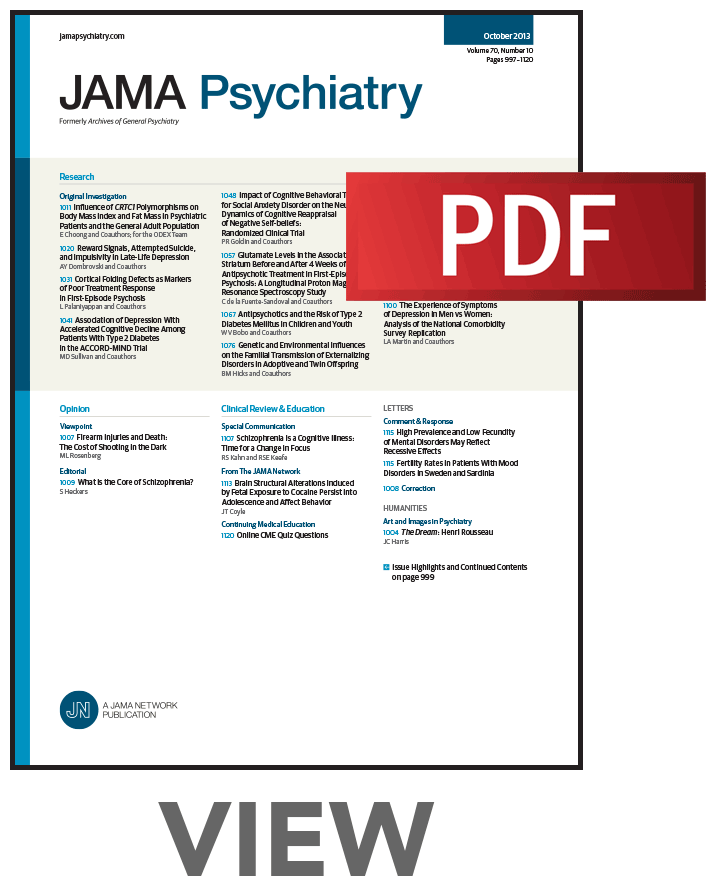Dopamine and Mood in Psychotic Disorders: An 18F-DOPA PET Study.
IF 17.1
1区 医学
Q1 PSYCHIATRY
引用次数: 0
Abstract
Importance There is limited neurobiological or trial evidence guiding treatment of comorbid affective syndromes in psychotic disorders. Given the use of dopamine-blocking antipsychotics, understanding dopamine function across these mood states is warranted. Objective To test for differences in dopamine synthesis capacity (Kicer) between affective syndromes across psychotic disorders and for association with psychotic symptom severity. Design, Setting, and Participants In this cross-sectional study using fluorine F 18-labeled fluorodopa (18F-DOPA) positron emission tomography (PET), individuals with first-episode psychosis and comorbid affective syndromes, including a current major depressive episode (MDE) or mixed/mania syndromes, and matched controls were recruited from early intervention services in inner-city London, United Kingdom. Data were collected from March 2013 to February 2022 and analyzed from October 1, 2023, to January 1, 2025. Exposure Striatal Kicer measured by 18F-DOPA PET. Main Outcomes and Measures Striatal Kicer and scores on the Positive and Negative Syndrome Scale, Hamilton Depression Rating Scale, Montgomery-Åsberg Depression Rating Scale, and Young Mania Rating Scale were determined. Results The study included a total of 76 individuals (38 with first-episode psychosis and comorbid affective syndromes [25 with MDE and 13 with mixed/mania syndromes] and 38 matched controls). The mean (SD) age was 27.2 (8.9) years overall, 30.7 (12.8) years among those with MDE, 23.7 (3.1) years among those with mixed/mania syndromes, and 26.0 (6.0) years among controls. Sex distribution did not differ (MDE, 13 [52%] male; mixed/mania syndromes, 8 [62%] male; controls, 25 [66%] male; P = .56). Kicer (controlling for age and sex) was significant across groups in whole striatum (F2,71 = 4.04; P = .02; R2 = 0.13). People with psychosis and MDE had lower Kicer compared with those with psychosis and mixed/mania syndromes (β [SE], 0.014 [0.001]; P = .02), with the largest difference observed in the limbic striatum (Cohen d = 1.57; P < .001). In the overall psychosis sample, higher striatal Kicer was associated with greater positive psychotic symptoms (R2 = 0.13; β [SE], 0.000066 [0.000030]; P = .03), notably in the associative striatum (R2 = 0.15; P = .02). No significant association was found in the limbic striatum. Conclusions and Relevance Kicer was lower in psychosis and comorbid MDE than mixed/mania syndromes, and transdiagnostically, greater positive psychotic symptoms were associated with higher Kicer in the associative, but not limbic, striatum. This subregion dopamine dysregulation has relevance for dopamine-modulating therapeutic agents and drug discovery.精神障碍中的多巴胺和情绪:一项18F-DOPA PET研究。
重要性指导精神障碍共病情感性综合征治疗的神经生物学或试验证据有限。考虑到多巴胺阻断抗精神病药物的使用,了解多巴胺在这些情绪状态中的功能是有必要的。目的探讨精神障碍情感综合征患者多巴胺合成能力(Kicer)的差异及其与精神症状严重程度的关系。设计、环境和参与者在这项横断面研究中,使用氟f18标记的氟多巴(18F-DOPA)正电子发射断层扫描(PET),从英国伦敦市中心的早期干预服务中招募了首发精神病和共病情感综合征的个体,包括当前的重度抑郁发作(MDE)或混合/躁狂综合征,以及匹配的对照组。数据收集时间为2013年3月至2022年2月,分析时间为2023年10月1日至2025年1月1日。用18F-DOPA PET测定暴露期ker。测定纹状体Kicer及阳性和阴性综合征量表、Hamilton抑郁评定量表、Montgomery-Åsberg抑郁评定量表和青年躁狂症评定量表的评分。结果该研究共纳入76例个体(38例首发精神病和共病情感性综合征[25例MDE, 13例混合/躁狂综合征]和38例匹配对照)。总体平均(SD)年龄为27.2(8.9)岁,MDE组为30.7(12.8)岁,混合/躁狂症组为23.7(3.1)岁,对照组为26.0(6.0)岁。性别分布无差异(MDE,男性13例[52%];混合/躁狂症,男性8例[62%];对照组25例(66%)男性;p = .56)。在控制年龄和性别的情况下,Kicer在整个纹状体组间显著(F2,71 = 4.04;p = .02;r2 = 0.13)。精神病合并MDE患者的Kicer较精神病合并混合/躁狂症患者低(β [SE], 0.014 [0.001];P = 0.02),其中边缘纹状体差异最大(Cohen d = 1.57;p < 0.001)。在整个精神病样本中,较高的纹状体Kicer与较高的阳性精神病症状相关(R2 = 0.13;β [se], 0.000066 [0.000030];P = .03),尤其是联想纹状体(R2 = 0.15;p = .02)。在边缘纹状体中没有发现明显的关联。结论:与混合/躁狂综合征相比,精神病和共病MDE的相关系数较低,而经诊断,更强的阳性精神病症状与关联纹状体的相关系数较高,但与边缘纹状体无关。该亚区多巴胺失调与多巴胺调节治疗剂和药物发现有关。
本文章由计算机程序翻译,如有差异,请以英文原文为准。
求助全文
约1分钟内获得全文
求助全文
来源期刊

JAMA Psychiatry
PSYCHIATRY-
CiteScore
30.60
自引率
1.90%
发文量
233
期刊介绍:
JAMA Psychiatry is a global, peer-reviewed journal catering to clinicians, scholars, and research scientists in psychiatry, mental health, behavioral science, and related fields. The Archives of Neurology & Psychiatry originated in 1919, splitting into two journals in 1959: Archives of Neurology and Archives of General Psychiatry. In 2013, these evolved into JAMA Neurology and JAMA Psychiatry, respectively. JAMA Psychiatry is affiliated with the JAMA Network, a group of peer-reviewed medical and specialty publications.
 求助内容:
求助内容: 应助结果提醒方式:
应助结果提醒方式:


